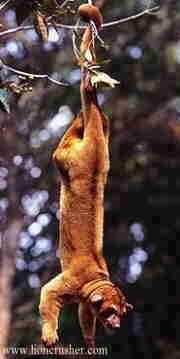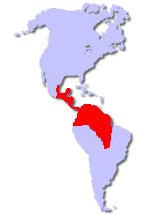 SKC Films Library SKC Films Library |
| SKC Films Library >> Science >> Zoology >> Mammals >> Order Carnivora >> Family Procyonidae |
| Kinkajou [king' kuh joo] Potos flavus Description The kinkajou is reddish brown to brown to gray in color. It has a slim body, grows to a length of about 3 feet, including the prehensile tail, and weighs from 3 to 8 pounds.
Distribution and Habitat The kinkajou inhabits the tropical rainforests from Mexico through Central America into central South America.
Diet Fruit makes up the bulk of the kinkajou's diet. Its favorite fruits include figs, grapes, bananas, melons, apples, and mangos. Most of its moisture is obtained from its food, but it will drink water that has collected on leaves and in nooks in the trees. When fruits are not in season kinkajous will eat berries, bark, leaves, frogs, insects, honey, avocados, birds' eggs, and small birds. They will also drink nectar from flowers, making them important pollinators. Habits and Behaviors The kinkajou is quite at home in the trees. The kinkajou is primarily nocturnal, spending its days in tree holes. Kinkajous are primarily solitary, coming together only to mate. Reproduction Females come into season every three months. One, sometimes two, cubs are born after a gestation period of 98 to 120 days. Eyes open between 2 to 6 weeks of age. Weaning occurs at 3 to 5 months of age. Males are sexually mature at 18 months, females at 30 months. Average lifespan of a kinkajou in the wild is 20 to 24 years. Scientific Classification Phylum Chordata |
| SKC Films Library >> Science >> Zoology >> Mammals >> Order Carnivora
>> Family
Procyonidae This page was last updated on June 15, 2017. |

